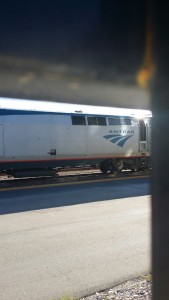Deeply frustrating are situations where Congress assures failure, after which those who wanted failure can say “told you so!” So, for example, the Internal Revenue Service budget has been cut in nominal and inflation-adjusted dollars since 2010. Now, Congressional Republicans—who are hardly fans of taxes or the IRS—blame delays and poor service on a poorly functioning Internal Revenue Service.
Today, though, I am focusing on Amtrak.
Why America Can’t Have Great Trains? by Simon Van Zuylen-Wood for National Journal on April 18, and the Japanese maglev train, caught my eye and provided the inspiration for this piece.
Amtrak has been around since 1970. It was created during the Nixon Administration, when President Nixon relieved the railroads of their obligation to provide passenger service. It was also created as a for-profit corporation. (On March 9 of this year, in Department of Transportation, et al. v. Association of American Railroads, the Supreme Court held unanimously that for at least some purposes Amtrak is a government agency.)
Andrew Haswell, a passenger rail expert, observed about the creation of Amtrak:
There was no question that it would probably not pay for itself. But the Nixon administration and other conservatives thought that once it was demonstrated that it wouldn’t pay for itself, it would be abolished.
Amtrak does truly operate with both hands tied behind its back. According to While Amtrak Subsidies Draw Fire From Congress, Aviation Gets a Free Pass by Angie Schmitt, written in March 2013, more than 30% of the Federal Aviation Administration and almost 70% of the Transportation Safety Administration budgets are subsidized. (The subsidy for streets and roads spending is about 50%.)
So what? Airlines charge less than would otherwise have to charge, if passengers were paying for a larger share of infrastructure and security costs. Drivers are not paying for the cost of streets and roads. And Amtrak charges more, to deal with the nominal subsidy it receives. So it’s a big deal!
Exacerbating the problem is the fact that the freight companies own the tracks. (Much of the land came from the federal government, free of charge, in return for building the tracks.) The freight companies must provide access to Amtrak, but the freight trains come first. That means a trip from Tucson to Los Angeles leaves five hours late and loses five more hours on the way, stopping on side rails to let the freight trains pass. (When you wake up at 5:30 and think the desert looks like the Palm Springs area, guess again; in four hours you’ve gone from Tucson to Maricopa!)
The world has been atwitter about the maglev train in Japan. (Here’s Japan’s Maglev Train Sets World Record: 603 kph from CNN with details.) Eighteen months ago the Japanese government was pitching its maglev to American politicians, in an attempt to capitalize on its $100 billion investment. Details are in Japan Pitches Its High-Speed Train With an Offer to Finance by Eric Pfanner for the New York Times on November 18, 2013.
And here in the United States? What about what many call the Obama Administration’s $11 billion train failure? According to The Truth about Obama’s High Speed Rail Program by Michael Grunwald for Time—published on August 11, 2014—Congress actually appropriated $10.5 billion. Of that sum, $2.4 billion was spent through August 2014. (Florida, a state which would have really benefitted from a modern rail system, turned down federal money and has done nothing. Because: freedom!) The rest of the money will be spent in the coming years, and train travel is faster and safer on many routes, and there are new routes.
For sure there are challenges for rail travel in the United States. Our geography does not lend itself to intercontinental passenger service, although those intercontinental routes are, for many in rural America, the only means for traveling 100-500 miles. We also have a “faster” culture, and the airline industry has a strong hold on many. (Going from DC to New York or vice versa? The train wins every time.) That all said, we’re missing a great opportunity to improve travel service for many, provide real jobs for hundreds of thousands of people, and modernize our transportation system for this century.


2 Responses to Amtrak: Failure Serving Political Purposes